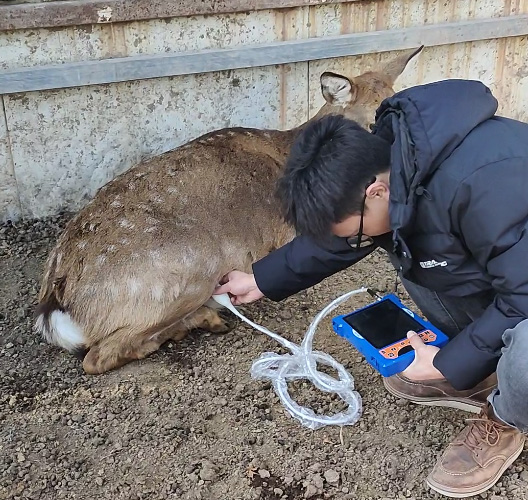Veterinary Ultrasound Methods for Sika Deer Examination
Sika deer veterinary ultrasound scanning machine
Veterinary ultrasound is a non-invasive diagnostic tool widely used in veterinary medicine, particularly for pregnancy testing and health checks of sika deer. Ultrasound technology allows farmers to clearly visualize the internal structures of sika deer and accurately diagnose their health and pregnancy status. The following are the main methods and steps for ultrasound examination of sika deer.

1. Choosing the Right Veterinary Ultrasound Equipment
Sika deer veterinary ultrasound scanning machine
For ultrasound examinations of sika deer, it is crucial to select a veterinary ultrasound machine that is appropriate for the animal’s size and needs. Veterinary ultrasound machines offered by brands such as Boxianglai typically feature high-resolution displays, high-definition image processing capabilities, a user-friendly interface, and probe designs suitable for large animals, ensuring accurate and smooth examinations.
2. Ultrasound Probe Selection and Placement
Common probe types for ultrasound examinations of sika deer include linear probes and abdominal probes. When selecting a probe, consider factors such as the deer’s size and the desired examination site.
Linear probes: Suitable for examinations of thinner skin and muscle layers. They provide clear, two-dimensional images and are widely used for fetal pregnancy testing. Abdominal Probe: For medium-sized animals like sika deer, an abdominal probe allows for deeper internal examinations.
Probe Placement:
Abdominal Examination: The probe is typically placed on the deer’s abdomen near the navel. To ensure clear images, apply conductive gel to the skin to enhance ultrasound transmission.
Back or Side Examination: Examinations from the back or side are sometimes also possible, especially when detecting early pregnancy.
3. Operational Precautions
When using a veterinary ultrasound system for sika deer ultrasound examinations, the following points require special attention:
Operating Environment: Maintain a quiet environment to minimize disturbance to the deer and prevent emotional instability from affecting the examination results.
Equipment Maintenance: Regularly inspect and maintain the ultrasound equipment to ensure the probe and display are clear and to avoid blurry images that could affect the diagnosis.
Personnel Training: Ultrasound equipment must be operated by a qualified technician to ensure accurate image interpretation.
4. Data Recording and Management
During ultrasound examinations, all test data (such as images, fetal size, 心拍数, 等。) should be recorded and saved promptly. This data will form the basis for subsequent management decisions. Veterinary ultrasound equipment from brands like Boxianglai is typically equipped with intelligent data management systems that automatically record and generate data reports for easy analysis and management.
Veterinary ultrasound technology is widely used in sika deer farming. It not only helps farmers accurately diagnose pregnancy status but also provides strong support for breeding management and health monitoring. Through the appropriate use of veterinary ultrasound equipment, farms can improve breeding success rates and optimize breeding profitability through scientific and efficient management.